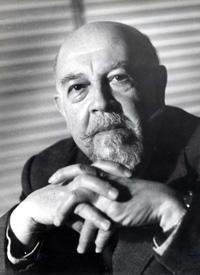Alfonso Reyes (Alfonso Reyes Ochoa)

Alfonso Reyes’ parents were Bernardo Reyes and Aurelia Ochoa. His father was in important government positions during the government of Porfirio Díaz, such as the governorship of Nuevo León and the Secretary of War and Navy. Alfonso Reyes was educated primarily in Mexico City. In 1909, he and other like-minded young intellectuals such as Martín Luis Guzmán and José Vasconcelos, founded the Ateneo de la Juventud to promote new cultural and aesthetic ideals and educational reform in Mexico. At the age of 21, Reyes published his first book, Cuestiones estéticas. The following year, 1912, he wrote a short story, La Cena (“The Supper”), considered a forerunner of surrealism and of Latin American magical realism. In that year he was also named Secretary of the Escuela Nacional de Altos Estudios at the National Autonomous University of Mexico. Reyes obtained his law degree in 1913, the same year that his father would die participating in an attempted coup d’état against the then president Francisco Madero. Alfonso Reyes was posted to Mexico’s diplomatic service in France in 1913. After Germany invaded France in 1914, he moved to Madrid, Spain, and pursued a literary career as journalist, investigator, translator, critic, and writer. In 1915, he wrote what is probably his best-known essay, “Visión de Anáhuac (1519),” with its famous epigraph, “Viajero: has llegado a la región más transparente del aire”, the source of the title of Carlos Fuentes’s novel La región más transparente. Reyes was reinstated in the diplomatic service in 1920. He was the second secretary in Spain in 1920, was in Paris from 1924 to 1927, then served as the ambassador to Argentina (1927–30 and 1936–37). He was the Mexican ambassador to Brazil from 1930 to 1935 and again in 1938. In 1939, he retired from the diplomatic corps and returned to Mexico, where he organized what is today El Colegio de México and dedicated himself to writing and teaching.
During his time in Spain, where he resided from 1914 till 1924, it was considered his best creative period and when he became a great writer and master of literature. In Spain, where he passed through hard financial times, he dedicated himself to literature and combined it with journalism; he worked in the Centro de Estudios Históricos (Historical Study Center) of Madrid under the direction of Sir Ramón Menéndez Pidal. In 1919 he was named the Mexican commission secretary “Francisco del Paso y Troncoso”, the same year that Cantar de mio Cid was put to prose. Many of his friends insisted that he was a natural in Spanish and should pursue a career in politics, but he didn´t follow their advice. One time he was presented with an offer to teach, but he rejected it too. He was more interested in the aesthetics of Benedetto Croce. He published numerous essays about poetry of the Spanish Golden Age, standing out among them: Baroque y Góngora; on top of that he was one of the first writers to study poetry of the Nun Juana Inés de la Cruz. From 1917 he produced Cartones de Madrid, his small masterpiece, Visión de Anáhuac, El suicida, and in 1921, El cazador. He was a collaborator of the magazines of “Revista de Filología Española”, Revista de Occidente and “Revue Hisanique”. His works about Spanish literature, older classical literature and aesthetics are notable, and among the more notable of that time, “Cuestiones estéticas” (1911). In Spain he organized a ceremony on September 11, 1923 in the Real Jardín Botánico de Madrid (Real Botanical Garden of Madrid) to honor the memory of the symbolic poet Stéphane Mallaramé.
After 1924 Alfonso Reyes developed a diplomatic and social life in Paris, Buenos Aires and Río de Janeiro. He translated a Mallarmé and edited his own literary mail, “Monterrey”, publishing it in 1930. He wrote friends abroad in every part of the world and gave discourses, spoke at conferences and contributed to homages and cultural reunions. He published among others, “Cuestiones gongorinas” (1927), “Capítlos de literatura espanñola” (1939-195), “Discurso por Virgilio” (1931). His poetic works reveal a profound knowledge of the formal means, notably “Ifigenia cruel” (1924), “Pausa” (1926), “5 casi sonetos” (1931), “Otra voz” (1936) and “Cantata en la tumba de Federico García Lorca” (1937). He left a left a legacy of work as a translator (Laurence Sterne, G.K. Chesterton, Antón Chéjov) and as an editor (Ruiz de Alarcón, Poema del Cid, Lope de Vega, Gracián, Arcipreste de Hita, Quevedo). Content in this edited section is translated from the existing Spanish Wikipedia article at es: Alfonso Reyes Ochoa; see its history for attribution.
Born
- May, 17, 1889
- Monterey, Mexico
Died
- December, 27, 1959
- Mexico



